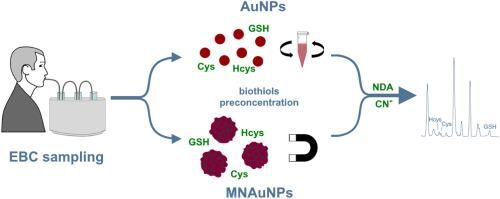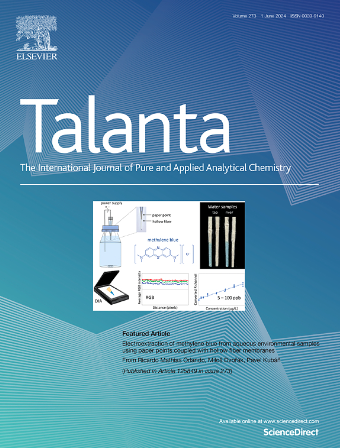用激光诱导荧光毛细管电泳分析金和金接枝的磁性纳米颗粒预富集后呼出液中的生物硫醇
IF 6.1
1区 化学
Q1 CHEMISTRY, ANALYTICAL
引用次数: 0
摘要
采用金和Fe3O4-Au复合磁性纳米颗粒对呼气凝析液(EBC)样品中的半胱氨酸、同型半胱氨酸和谷胱甘肽进行选择性萃取和富集。采用级联式EBC进样器,采集1 mL EBC,提取生物硫醇,预浓缩因子为8 ~ 34。提取过程包括将硫醇与纳米颗粒结合,将其从样品基质中分离,然后使用二硫苏糖醇(DTT)将其从纳米颗粒中释放出来。预浓缩的硫醇随后与萘-2,3-二甲醛衍生。这种衍生化方法允许使用高浓度的DTT,而不会由于-SH基团的存在而干扰分离步骤。分离在pH为10的10mm硼酸钠缓冲液中进行。构建了具有成本效益的405 nm激光诱导荧光检测器,并将其用于检测。半胱氨酸、同型半胱氨酸和谷胱甘肽的检测限分别为0.24 nM、0.63 nM和0.71 nM,在0 ~ 50 nM范围内呈线性关系,R2为0.9948 ~ 0.9998。以峰面积RSD表示的精密度在6.8% ~ 8.7%之间。EBC样品中半胱氨酸、同型半胱氨酸和谷胱甘肽的平均相对峰回收率分别为76%、84%和80%,在三种不同浓度水平下的平均相对峰回收率为54% ~ 112%。此外,对Fe3O4-Au磁性纳米颗粒进行了测试,实现了快速磁分离,减少了处理时间,突出了自动化的潜力。该优化的预浓缩程序显示了高效的生物硫醇提取,检测限极低,首次能够同时分析EBC中这三种硫醇。本文章由计算机程序翻译,如有差异,请以英文原文为准。

Capillary electrophoresis with laser induced fluorescence for the analysis of biological thiols in exhaled breath condensate after preconcentration using gold and gold-grafted magnetic nanoparticles
Gold and Fe3O4–Au composite magnetic nanoparticles were employed for the selective extraction and preconcentration of cysteine, homocysteine, and glutathione from exhaled breath condensate (EBC) samples. Using a cascade type EBC sampler, 1 mL of EBC was collected, and biological thiols were extracted and preconcentrated with preconcentration factors ranging from 8 to 34. The extraction process involved binding thiols to nanoparticles, separating them from the sample matrix, and then releasing them from the nanoparticles using dithiothreitol (DTT). The preconcentrated thiols were subsequently derivatized with naphthalene-2,3-dicarboxaldehyde. This derivatization method allowed for the use of high DTT concentrations without interfering with the separation step due to the presence of the –SH group. The separation was performed in a 10 mM sodium borate buffer at pH 10. A cost-effective 405 nm laser-induced fluorescence detector was constructed and utilized for detection. The method was linear between 0 and 50 nM, with R2 in the range of 0.9948–0.9998 and LODs of 0.24 nM, 0.63 nM and 0.71 nM were achieved for cysteine, homocysteine and glutathione, respectively. The precision expressed as RSD of peak areas was between 6.8 and 8.7 %. The average relative spike recoveries for cysteine, homocysteine and glutathione in EBC samples were 76 %, 84 %, and 80 %, respectively, with a range of 54 %–112 % across three different concentration levels. Additionally, Fe3O4–Au magnetic nanoparticles were tested and enabled rapid magnetic separation, reducing processing time and highlighting the potential for automation. This optimized preconcentration procedure demonstrated efficient biothiol extraction with very low detection limits, enabling, for the first time, the simultaneous analysis of these three thiols in EBC.
求助全文
通过发布文献求助,成功后即可免费获取论文全文。
去求助
来源期刊

Talanta
化学-分析化学
CiteScore
12.30
自引率
4.90%
发文量
861
审稿时长
29 days
期刊介绍:
Talanta provides a forum for the publication of original research papers, short communications, and critical reviews in all branches of pure and applied analytical chemistry. Papers are evaluated based on established guidelines, including the fundamental nature of the study, scientific novelty, substantial improvement or advantage over existing technology or methods, and demonstrated analytical applicability. Original research papers on fundamental studies, and on novel sensor and instrumentation developments, are encouraged. Novel or improved applications in areas such as clinical and biological chemistry, environmental analysis, geochemistry, materials science and engineering, and analytical platforms for omics development are welcome.
Analytical performance of methods should be determined, including interference and matrix effects, and methods should be validated by comparison with a standard method, or analysis of a certified reference material. Simple spiking recoveries may not be sufficient. The developed method should especially comprise information on selectivity, sensitivity, detection limits, accuracy, and reliability. However, applying official validation or robustness studies to a routine method or technique does not necessarily constitute novelty. Proper statistical treatment of the data should be provided. Relevant literature should be cited, including related publications by the authors, and authors should discuss how their proposed methodology compares with previously reported methods.
 求助内容:
求助内容: 应助结果提醒方式:
应助结果提醒方式:


